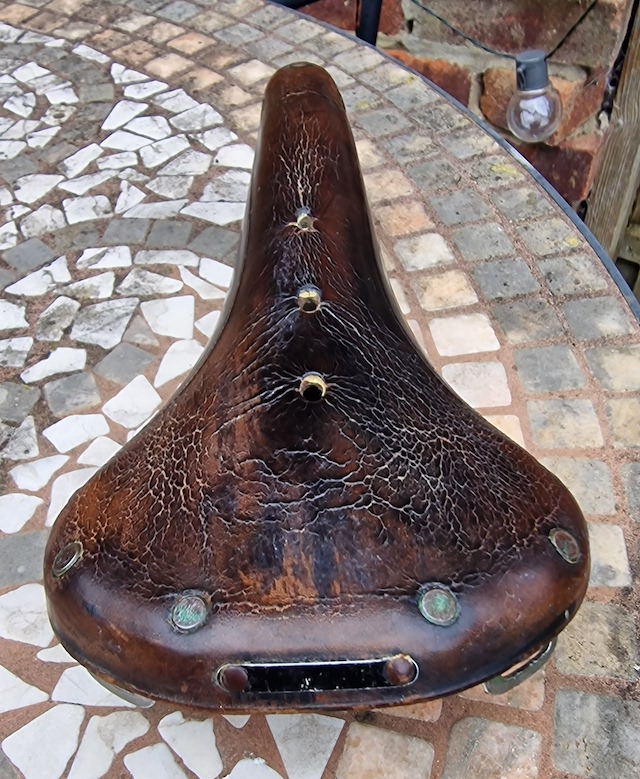
Brooks B17
A supremely comfortable saddle for touring use. Possibly my oldest bike component that is still in use (even if only occasionally).
During a recent garage clearout, I unearthed this saddle. It's clearly seen better days - the surface of the leather is a bit cracked and the rivets are a bit green! These photos were taken after I applied some Proofide.


Back in the early 1970s, my father bought me and my brother a 10-speed Puch sports bike each, partly to ride to school and back but also as a route to a bit of youthful independence.
Of the two of us, I think I took to cycling quite quickly, and I can remember buying a few upgrades to the bike including a replacement saddle. Even back then, saddles were a component that was often a point of cost saving on a budget bike. Later on, my brother went further afield than I did, including a trip with my father to Cape Wrath.
Having been an active club cyclist in the 1950s, it was perhaps natural that my father’s advice as to a replacement saddle gravitated to the legendary saddle maker Brooks. Over the years, Brooks has changed ownership - at one point part of Raleigh bicycles, it’s now owned by the Italian firm Selle Royal who to their credit seem to be maintaining its identity. Brooks was established in 1866, and produced bicycle saddles from the mid 1880s.
The saddle I adopted was a B17 Narrow - this model is one of a pair of models of B17, the other being the standard width version. The B17 wasn’t the top racing model in Brooks’ lineup, but more of a general purpose saddle. The first B17s were produced in the mid 1890s, so they've been in production for around 128 years now, which is probably quite unusual for bicycle components.
There’s a good deal of mythology or mystique about Brooks saddles and how long it takes to ‘break them in’, but in my experience (and that of my tandem stoker) that’s all a bit exaggerated in the case of the B17. I’ve never had any discomfort issues with a B17 (and I’ve had a few B17s, all from new). The same can’t be said for a Brooks Swift that I cannot use for more than 60 miles! I think the secret to the B17 is that the leather is suspended between the nose and the rear of the saddle rail, which affords a considerable degree of suspension, and that the leather used has a bit of 'give' in it.
At any rate, this particular B17 was used on my first bike for many years, though it has to be noted that while I was at University, the bike didn’t really get a whole lot of use.
In 1990, I moved to Dundee and restarted my cycling. My partner and I bought a secondhand Dawes Super Galaxy tandem and as is usual in these matters began upgrading some of the components, and obviously the saddles were changed. I immediately fitted my old B17, while my stoker tried a variety of saddles ostensibly designed to suit female anatomy (none of the did!) before settling on a B17 Standard, a model she’s stuck with to this day.
So my old B17 had a new lease of life, used weekly and through many cycle tours from 1990 to around 2015 and beyond. Eventually, I became a little concerned about the cracks in the leather and replaced it with a Brooks Cambium C17 Carved, which has the advantage of being rather more weatherproof than the leather saddles, and is actually just as comfortable.
Hilary Stone wrote an excellent article about the Brooks B17 and its variants for Classic Lightweights. Given the Brooks B17 has been available for around 128 years, and that my saddle has been around for a significant proportion of that time, I am rather impressed. I wouldn't fit a B17 on one of my racing bikes, but for a touring bike, there's little to compete with it on comfort.
When you subscribe to the blog, we will send you an e-mail when there are new updates on the site so you wouldn't miss them.
Comments